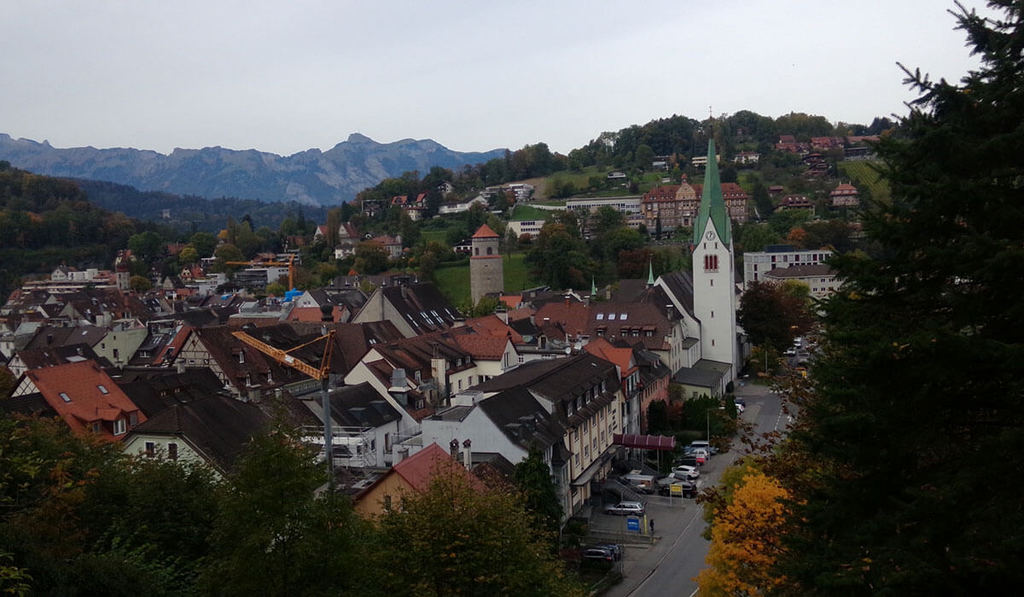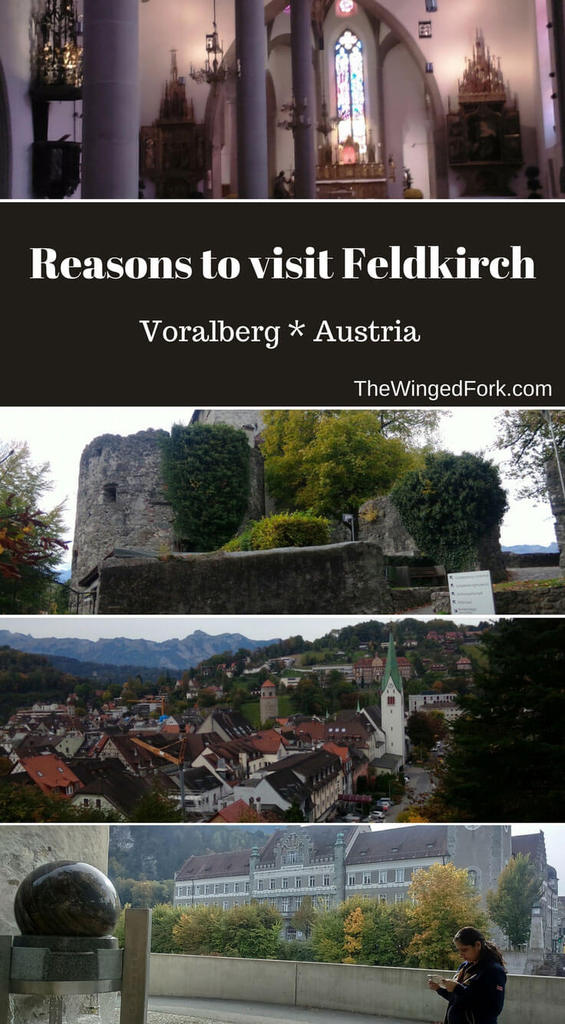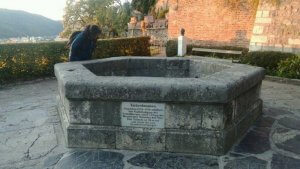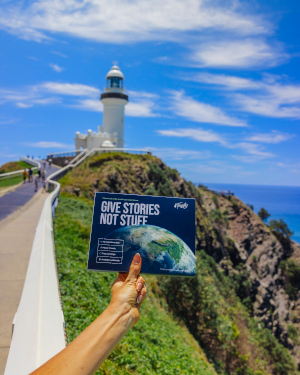Feldkirch is a medieval town in the mountainous state of Voralberg in Austria. It was the last stop of our journey through Austria. The reason we chose to stay in Feldkirch? We wanted to see Liechtenstein. Yeah, we wanted to get that 2 Euro stamp on our passport saying we had visited the 6th smallest country on the planet.
Yes, we’re planning on visiting the 2nd to the 20th smallest countries, because almost everyone else including us has visited the smallest country in the world, the Vatican. It’s probably the country that sees the most tourist traffic too!
Anyway, Voralberg shares borders with Germany, Switzerland and Liechtenstein, while Feldkirch shares borders with Liechtenstein and Switzerland. Feldkirch is famous for the Schattenburg Castle that’s located on top of a hill.
It’s also famous for being near the Austrian River Ill that flows into the Rhine. Of course, this is different from the French River Ill that also flows into the Rhine further downstream.

My sis and I stayed at the place of a friend that we met while Couchsurfing, Denise. Her home was lovely and we enjoyed the company of her little angel Raphael. He’s quite active and calls you mit (with) him to play quite often. Abby mit, Sarah mit!
Another thing we loved about their place was that instead of a fence in some parts, the hedges literally had apples growing on them. You could just pluck and eat. 🙂 Which reminds me, Denise’s mom makes a mean Kaiserschmarrn mit Apfelmus. Tastes awesome!
And the weather was gloomy when we were there, which was perfect for us because we get sunburnt easily. So give us gloomy or cloudy weather anytime!

Anyway, so we went to the Town Centre and got info and maps from the Montfort Haus. Monfort Haus was constructed in place of the old event centre and is prided for its architecture, soft twisted shape and sustainable design. It serves as an event centre and also as the tourist office.

So the map from the tourist centre says that around the corner is a very old rock wall that was part of the original fortifications of Feldkirch. So off we go on our first discovery.

‘Oh, we found it!’ As quick as that! We checked the map a couple of times to make sure it was the right place. It was. Ha! That was a really quick end to the adventure.
1. St John’s Church or Johanniterkirche

So onwards to our next stop, St John’s Church or Johanniterkirche as it’s called locally. Founded by Count Hugo of Montfort in 1218, this served the Order of Saint John. The church has also served as a workshop and school at different times, before finally being turned into an exhibition centre. But it was closed when we got there. 🙁
There is supposedly a depiction of a knight called “Blasi” on the gable, but we couldn’t see it. We could however see the homily of Saint John the Baptist up there on the gable. This fresco was the handiwork Glorus Scheel.
2. Marktgasse or Market Street

There are a number of flower vendors on the pavement of Marktgasse right outside Johanniterkirche.

And further up Marktgasse are other vendors and restaurants; and hidden behind the archways are the stores. Marktgasse or Market Street is a popular street with German architecture that’s been the town’s main market area since the middle ages.
3. Schattenburg Castle Museum
From here it’s off to find the infamous Schattenburg Castle Museum which is situated at the top of a hill on Burggasse street and nestled against the backdrop of the mountains.
A short 10 minute walk from the bust stop; followed by about 15 minutes up the long steps to the top at a leisurely pace. Be ready for some exercise. 🙂 And we take pics of the random bursts of greenery on the way.

Once we get to the top, we find there’s the Castle Museum and also a restaurant. I love the big wooden doors at the entrance to the Castle.
The Schattenburg Castle was built between 1230 and 1265 AD and was the seat of the Counts or Earls of Montfort until 1390 AD. Hugo I of Montfort who founded the city of Feldkirch, started construction of the Castle on a hill East of the town in 1230 AD.

After the Montforts, it was ruled by the Earls of Bregenz and the Hasburgs. The Castle was renovated and extended in the 15th Century by Count Friedrich von Toggenburg and then by Vogt Hans of Königsegg. During the 1800’s the castle fell to ruin, till it was purchased for 833 florins by the town of Feldkirch.

There was this one leaf I found fascinating. I tried to get a pic. But it was just too out of the camera’s line of sight. 🙁


The view of the town of Feldkirch and the Domkirche Sant Nikolaus from the Castle is amazing. You can see the Alps in the distance. Well, I think they’re the alps. Anyway, the Schlosswirtschaft Schattenburg restaurant in the Castle is supposedly a must eat place. But it was closed when we got there. I think they’re closed on Mondays.
A lot of people have lauded the food and the service at the restaurant, while some review on Tripadvisor have claimed it to be a bit spooky. Who knows?

So on the other side of the Castle at the top is a road, the Schlosssteig. And yes, after coming up here we find out that it is possible to drive up here. Well, it doesn’t matter to us anyway, since we don’t have a vehicle. But if you do, keep in mind that the tunnel that literally goes under the Schattenburg just before turning on to Marokkanerstrasse actually comes out somewhere on Bettlerstiege near Schlosssteig. So you can get up there faster if need be. Just check with the locals first, we didn’t take the tunnel.

The Castle is literally in the mountains. This is what you see when you come out on the other side. And I love the paneling on those old style houses? See the one on the left in this pic? Or both the houses in the previous pic. I wish I lived in one of those.
4. RadioMuseum Feldkirch
Anyway, we go back down the steps and search for the famous RadioMuseum Feldkirch on Burggasse. But it turns out to be closed.
The proprietor only opens for a few hours from 1 pm to 4 pm on Tuesdays and Wednesdays, or by prior appointment on other days. Bummer we didn’t know that.
We look it up online and find out that the RadioMuseum is a veritable storehouse of radio equipment from the last few centuries; from radios, receivers, TVs, tape recorders, gramophones and more. You could almost feel like you’re with Marty McFly and Doc Brown in Back to the Future.

5. Domkirche St. Nikolaus
Voralberg’s largest cathedral, the Dom St. Nikolaus or Domkirche Sant Nikolaus or Cathedral of Saint Nicholas or Dompfarrantkirche Nikolas, was built in the 13th century with a Romanesque design.
It was damaged in the Feldkirch fires of 1348, 1396 and 1460, and finally rebuilt by In 1478, Hans Sturn was a master builder who rebuilt the church with its current gothic design. The pics speak for themselves.
The only problem we had here was a lady beggar coming in the church and pestering us for more money, but the locals shooed her away.
6. Cats Tower or Katzenturm

The Katzenturm or Cats Tower was built somewhere between 1491 to 1507 and is part of the fortifications of the city of Feldkirch. This 40 metre tower was transformed into a bell tower in 1665.
The Katzenturmglocke, or the Cats Tower Bell is Austria’s 6th largest bell and lovingly called the Pummerin by Feldkirch locals. The bell was first cast in 1665 and later recast by Josef Anton Grassmayr II in 1857, and weighs about 8.5 tons.

We wanted to catch a glimpse of the bell, but it was closed. I’m not sure if it’s open to the public at all. The bell is rung at 1500 hours every Friday to remind us of Christ’s death. It also rings on other auspicious occasions.
7. Wasserturm
Some distance away is the Wasserturm or Water Tower which was built in 1482 . The names dates back to the time that the tower had an entrance to the River Ill in it.

For the last 50 or 60 years, the tower has been used as a club house by the locals. There is a painting on the western wall of the tower representing a Bindenschild coat of arms.

Outside the Wasserturm , there’s a revolving globe with water flowing over it and into a small pool below. We tried to figure out the mechanics. It looked like it was powered by something. Not sure though! There was also the Pulverturm or Powder tower at some distance from this place on Mühletorplatz, but we don’t go to visit it.

There’s a building across the river from the Wasserturm that looks inviting with it’s reddish roof and detailed gables, we think we should go and visit.
So we cross the bridge to Schillerstraße or Liechtensteiner Straße on the other side of the River Ill and standing in front of the building realize that it’s the Justizanstalt Feldkirch, or the Prison Feldkirch. Oops! Nope, don’t want to go in there!
Justizanstalt Feldkirch is the only prison in the state of Voralberg and shares the building with the Regional Court of Feldkirch aka Landesgericht Feldkirch.
The building’s facade is replete with gothic and renaissance features, such as gables with mosaics of the Austrian symbol along with the coat of arms of the Counts of Werdenberg and Counts of Montfort.
8. Rathaus

We walk back towards where we’re meeting Denise and pass the Rathaus or Townhall of Feldkirch, the administrative centre of Feldkirch for over 500 years.
The current version of the frescoes on the Rathaus were designed by artist Nikolaus Prachenky. There are a number of frescoes depicting Saint Nicholas, the city’s patron saint, or Count Rudolf V handing over the keys of the city to the people and more.
It could actually take another entire blog post if I were to describe them. But you best go see for yourself. 😉

9. Kappuziner Kloster
The KappuzinerKloster is a monastery in Feldkirch of the Cappuchin order. The foundation stone of the KappuzinerKloster was laid in 1602 and service started in 1605.
The patron saint is St. Fidelis of Sigmaren who protected the church in 1621 and was beheaded in 1622. His head is preserved as a relic here.
There is a Fideliskapelle outside the church paying homage to St. Fidelis. Bottom right hand of the pic. Just couldn’t get a good pic with the trees in the way.
10. Churer Tor

Built in 1270 and then rebuilt in 1491, the Churer Tor was one of the city gates of Feldkirch. It was also called the Hewers or Salztor, meaning Salt Tower or Salt Gate as it was primarily used as a storehouse of salt from the Salzstadel.
In times past, an important trade route led through this Salt gate over the Heiligkreuzbrücke or Holy Cross Bridge, the only crossing at that time over the River Ill in Feldkirch.
Anyway, back we went to Denise and off to the neighbouring town of Bregenz to see Lake Constance.
11. Bodensee or Lake Constance

Lake Constance is a beautiful vast lake bordered by Austria, Germany Switzerland. Because it’s made up of 3 water bodies – the Untersee, Obersee and Seerhein – it’s called Bodensee.
There’s a lot to do here – walking, hiking, biking, bird watching, boating and more. I have a few more pics where the lake looks better, but then there’s the three of us making faces in it. So nope, that’s not going on here. 😛

Bregenz Festival BodenseeWe were too early for the famous opera festival called Bregenz Festival. The stages were still under construction this year. But we did get to see a display what the previous year’s stages looked like. Do those even look like stages? Must be magnificent to watch it live.
There’s a lot more to do in Bregenz, but we were on a short trip with only a few days off from work, so we couldn’t try any of the other things – boating, cable car rides at Pfander Mountain, and more. So back to Feldkirch to bunk down for the night.
Anyway, our stay in Feldkirch was pleasant and fun. It’s one of those towns that you can visit for just a day or two.
Or if you’re in a hurry, you might just be able to see everything in half a day. But being situated in the middle of the mountains it makes for great scenery.
And if you have more time on your hands for a little adventure there are quite a few hiking trails and rock climbing options available nearby for all skill levels.
For example, the Drei Schwestern or Three Sisters Mountain. We wished we had the time to see the three peaks.
The next day we did our half day trip to Liechtenstien. But let me till you about that a little later…
Other Popular Posts about Travel in Europe
- Where To Go Snorkelling In Mallorca?
- Tongariro Hikes
- Why Visit Switzerland?
- What to eat in Vienna
- What to do in Graz






I’m an East Indian foodie and travel blogger from Bombay, India. I’ve travelled across parts of Europe and Asia, and love writing about my experiences with people and cultures. And naturally, I love food, wine, and travel, and have an endless bucket list of places to go to, and experiences I must blog about.
I also love baking and experimenting with food, with a little help from my family. If you must know, my favorite things are nice rainy days, the smell of cakes in the oven, playing in the snow, glasses of wine, and dark chocolate.
More info about me here!





